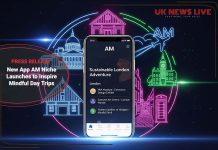It was not very long ago, most people thought it was good enough to cook and eat three regular meals a day with beverages to satisfy their thirst.
Often, they snacked only in between their mealtimes. This eating model was ideal while life was easy and the eating behaviours were organized and predictable.
During the last Covid-19 pandemic lifestyles have been impacted by lockdowns and isolation periods and many more people started working remotely or from home.
That’s where modern food and snack delivery as boxed packaged goods comes in.
As workers lost time cooking their meals at home while working from home, more companies arranged for them to get snacks and meals delivered to reduce the lunch hours.
Self-employed remote workers also realised the value of having their food delivered regularly in the form of hygienic boxed packaged goods, also saving them time by not having to wash dishes and doing household chores.
Many London restaurants also started offering such delivery services as they lost office workers coming in for lunches and dinners.
Previous & modern food cultures and shifts
Back in the day, the meals played a very significant role, not only health-wise but culturally as well. It not only helped in creating and maintaining a bond between the family members when they all took their meals together at the same place and at the same time and eating ten same food, but it also traditionally helped in structuring the day.

It seems that the culture of food is ever-changing and in constant motion. When you consider the modern eating culture you will see that it is marked by two specific things such as:
- Fragmentation and
- An overturning of tradition.
Most of the people now know and idealize the concept of having three balanced meals in a day but seldom eat that way.
- Moreover, in these days and times, planning for meals, shopping for the items and cooking all are decentralized.
- Add to that there seem to be very fewer rules about what specific items to eat and drink.
As a result, people end up eating anything and everything whenever they need to, and most of the time they end up eating fast foods that are unhealthy, unsafely prepared and contains little or no nutritional value.
People now seem to be more comfortable with eating on the fly. They are less keen on cooking their meals and snacks and often rely on meals and snacks delivery by the food delivery companies in practically and ideally eco-friendly boxed packages.
Moreover, in business, today none of the eating or drinking occasion characterizes the fragmented and decentralized modern eating culture that typically follows no specific rules than snacking.
Modern Snacking Scenario – Convenient Delivery as Boxed Packaged Goods
It is important to know what modern snacking exactly looks like. Here it is:
- Snacking occasions now actually reflect the fact that the consumers are more flexible in their approach to eating and drinking overall. In fact, studies have found that this actually comprises of nearly 50% of all food and beverage occasions.
- The consumers today eat and drink around their schedules instead of scheduling around the mealtimes.
According to the modern eating schedule:
- Dinner has become a meagre pause between their other activities.
- Lunch, on the other hand, is the most suffered one and is often scheduled out to accommodate a surfeit of must-dos and meetings and
- Breakfast is most often multitasked between communicating, working and even commuting.
All these show that having food now has more of an ad hoc approach to mealtimes rather than a necessity for a healthy living. It is now increasingly a part of the new and busy routine if the individuals.
Therefore, it can be concluded from the above that, while dinner remains the most important social meal occasion, lunch and breakfast happen to be more of routine snacks for most of the people, especially during the weekdays.
The primary reason for people following this trend is that it opens up plans and schedules and at the same time it frees up the time for shopping, planning, cooking and cleaning.
Therefore, if you compare traditional and modern snacking you will see that:
- Traditional snacking was more infrequent and was very much dependent around the concept of having three square meals a day paradigm.
- Modern snacking patterns, on the other hand, look much different form it where meals do not go away but there is an all-day approach to snacking.

This change in approach and concept of modern snacking ultimately impacts not only the significance of the meals but also the health of the consumers as well. This is because to the modern people the quality of meals is less significant as now snacking is more important to them.
Asa result there is an increase in the snacks delivery orders rather than meals from restaurants during breakfast and lunchtime, especially in the office settings.
Difference of Snacks and Meals
Ideally, snacks differ from the meals in three discrete ways. Characteristically, snacks are viewed as those that are taken in:
- The smaller size and even if it is taken during the mealtime, it is often considered as a stand-in for the next ‘large eating’ occasion
- Between times as it intuitively falls in the grey areas between meal times that are assigned both socially and culturally.
Snacks are those that require low prep and clean-up time. These typically involve no construction and may only need brief and unattended heating at times for specific snacks items.
Snacking now represents a more dynamic and significant portion of the eating and drinking behaviour of almost everyone. Studies reveal that:
- 90% consumers have snacks multiple times in a day
- 7% of these consumers skip meals altogether and prefer all-day snacking
- 80% of all snacking is purposeful as it fulfils all physical, emotional, social and cultural desires and
- 20% of all snacking is aimless and is typically driven by the awareness and availability of food rather than its needs.
Most importantly, it is the faster delivery of the snacking items that has changed the meal times and behaviour of the common people.





























